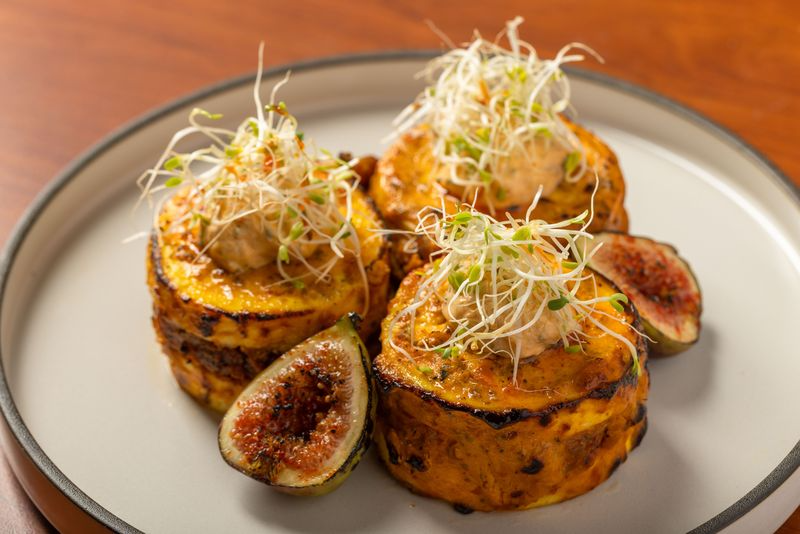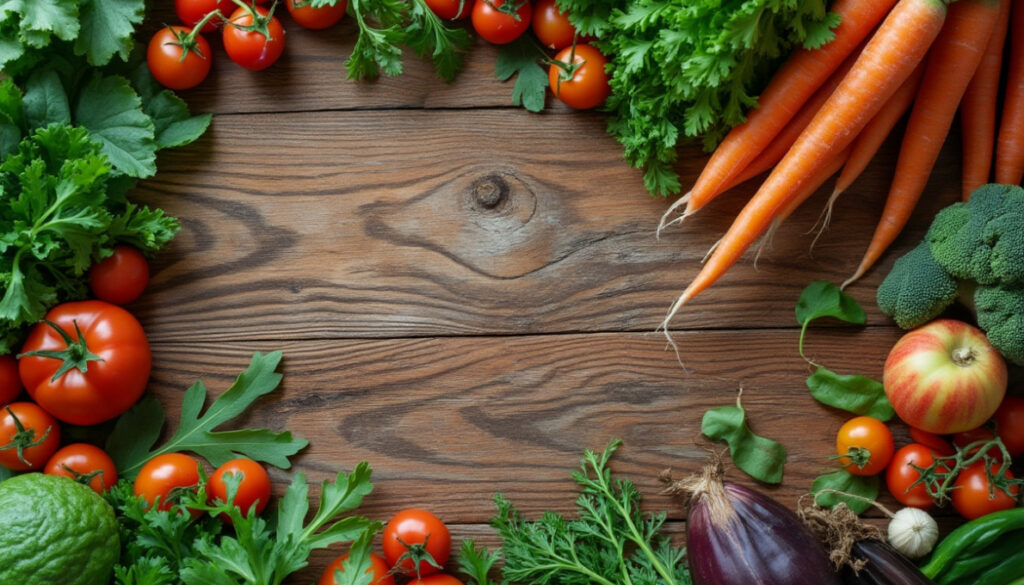The Future of Dining: How Food Sustainability Is Reshaping Our Plates
Food sustainability trends are rapidly changing how we grow, package, distribute, and consume food worldwide. For those seeking quick insights into what’s shaping sustainable food in 2024, here are the key trends:
- Regenerative Agriculture – Farming practices that restore soil health and improve biodiversity
- Innovative Packaging Solutions – Compostable, biodegradable, and upcycled materials reducing waste
- Plant-Based Evolution – Moving beyond processed alternatives to whole food plant options
- Technology-Improved Traceability – Blockchain and AI creating transparent supply chains
- Food Waste Reduction – Circular economy approaches and upcycled food products
- Consumer-Driven Change – Millennials and Gen Z demanding sustainable practices
As our planet faces unprecedented environmental challenges, the food industry stands at a critical crossroads. With food production contributing significantly to greenhouse gas emissions, water usage, and land degradation, the way we produce and consume food has never been more important.
“For the first time in the history of the human race, there is the technology and the will to eliminate hunger on a global scale.”
The statistics paint a stark picture: 33% of all food produced globally is wasted, contributing to 8% of global greenhouse gases. Meanwhile, 141 million tonnes of plastic packaging are produced each year, much of it for food products.
Yet there’s reason for optimism. From farm to table, innovators are reimagining our food systems. Restaurants are adopting zero-waste principles. Farmers are switching to regenerative methods that actually improve soil health. Food companies are embracing transparency through blockchain technology, allowing consumers to trace ingredients from source to plate.
What’s driving these changes? Consumer demand is perhaps the most powerful force. Approximately 32% of Millennials and 25% of Gen Z base their purchasing decisions on sustainability factors. This demographic shift is forcing the entire industry to adapt or risk being left behind.
For travelers and food enthusiasts, understanding these trends isn’t just about making ethical choices—it’s about experiencing the cutting edge of culinary innovation that’s creating more flavorful, nutritious, and sustainable dining experiences worldwide.

Top Food Sustainability Trends Changing the Culinary World
The culinary world is experiencing a remarkable change, and it’s one driven by our collective concern for the planet. As food lovers journey across continents seeking memorable meals, we’re witnessing how food sustainability trends are fundamentally reshaping restaurants, farms, and food businesses in every corner of the globe. These aren’t passing fads that will disappear next season—they represent deep, meaningful shifts in how our entire food ecosystem operates.
The numbers tell a compelling story. A recent global consumer insights report reveals that 93% of consumers worldwide now consider sustainability important when making food choices—a significant 6% increase from 2019 in developed markets. Even more telling, 68% of consumers have actively changed their food and beverage habits in the past year specifically for sustainability reasons.
Jenny Zegler, Director at Mintel Food & Drink, puts it perfectly: “Scrutiny of processing use in the food and drink industry is intensifying. Fuelled by discussions about highly, overly or ultra-processed food, feelings about processing will inspire consumers to look more closely at ingredients, nutrition and production.”
This heightened awareness isn’t just changing what we eat—it’s changing how our food is grown, packaged, distributed, and served. Farmers are adopting regenerative practices that heal the soil. Restaurants are designing menus that minimize waste. Food producers are reimagining packaging to reduce environmental impact.
What makes these food sustainability trends so powerful is that they’re being acceptd by everyone from Michelin-starred chefs to home cooks, from multinational corporations to small family farms. The movement is gaining momentum because it delivers multiple benefits: healthier ecosystems, more nutritious food, reduced waste, and often, more flavorful dining experiences.
For travelers who seek authentic culinary trips, understanding these sustainability shifts offers a deeper appreciation of the meals we enjoy. It connects us to the stories behind our food—the farmers who grew it, the innovative minds who transported it with minimal environmental impact, and the chefs who transformed it into something delicious while honoring its origins.
Let’s explore the major food sustainability trends that are reshaping dining experiences worldwide, from the soil beneath our feet to the memorable meals on our plates.
Regenerative Agriculture: Cultivating a Sustainable Future
Regenerative agriculture represents perhaps the most fundamental shift in sustainable food production. Unlike conventional farming that often depletes soil and reduces biodiversity, regenerative practices aim to restore ecosystem health while producing nutritious food.

When I visited a regenerative farm in Vermont last summer, I was struck by the stark contrast to conventional fields. Instead of barren soil between crop rows, wildflowers bloomed alongside vegetables. Birds and insects buzzed with activity. The farmer explained that regenerative agriculture goes beyond organic farming by actively improving the environment through several key techniques.
Rather than tilling the soil—which disrupts its natural structure—regenerative farmers use minimal or no-till approaches. They plant cover crops that prevent erosion while naturally fertilizing the ground. Thoughtful crop rotation manages pests without chemicals, while carefully managed grazing mimics how wild herds naturally maintain grasslands. Instead of synthetic fertilizers, they rely on composting and natural amendments that feed soil microbes.
This movement is gaining serious momentum. According to industry reports, food sustainability trends show regenerative agriculture moving from niche to mainstream, with major food manufacturers now highlighting these techniques on product labels. That said, there’s growing concern about standardization—two-thirds of publicly-listed agrifood companies discussing regenerative practices lack formal, quantitative targets.
As Dr. Chad Moutray notes: “Younger generations, in particular, seem to want more transparency where food sourcing is concerned.” This demand is pushing companies beyond vague sustainability claims toward measurable regenerative practices.
At The Dining Destination, we’ve seen innovative restaurants creating magical dining experiences through direct partnerships with regenerative farms. These collaborations aren’t just good for the planet—they’re creating new culinary possibilities that showcase the superior flavor and nutrition of regeneratively grown ingredients.
Benefits and Challenges of Implementing Regenerative Agriculture
The benefits of regenerative agriculture extend far beyond the farm fence. According to recent research published in the Journal of Environmental Management, these practices create a cascade of positive effects.
Perhaps most exciting is soil carbon sequestration. Healthy soil acts like a carbon sponge, pulling significant amounts of CO2 from the atmosphere and locking it away—a natural climate solution happening right beneath our feet. The improved soil structure also holds water better, making farms more resilient to both droughts and floods.
Biodiversity flourishes when chemicals are reduced and diverse plantings are introduced. From soil microbes to pollinators to birds, entire ecosystems begin to recover. And there’s growing evidence that foods grown in this living, biodiverse soil contain higher levels of vitamins, minerals, and antioxidants—you can literally taste the difference.
Economically, many regenerative farmers report greater resilience. Though initial yields may decrease during transition, input costs drop significantly without expensive chemicals. Plus, consumers increasingly seek out (and pay premium prices for) regeneratively grown foods.
But let’s be honest—transitioning to regenerative agriculture isn’t all sunshine and rainbows. Farmers face real challenges, including knowledge gaps about these less-common techniques. The economic transition period can be tough, with yields sometimes dipping before soil health improves. Unlike organic certification, there’s no standardized certification for regenerative practices, creating confusion in the marketplace.
Many farmers also struggle to find buyers who truly value and will pay premiums for regenerative products. And our current agricultural policies often favor conventional practices, creating structural barriers to change.
Despite these problems, food sustainability trends clearly indicate regenerative agriculture will continue to expand. Forward-thinking restaurants and food businesses are creating crucial market demand for these ingredients while educating diners about their benefits. When we choose regenerative options while dining or traveling, we’re not just enjoying better flavors—we’re helping cultivate a more sustainable future, one meal at a time.
Innovative Packaging Solutions: Reducing Waste from Farm to Table
Packaging might be the most visible face of food sustainability in our daily lives. With a staggering 141 million tonnes of plastic packaging produced annually—much of it used once and discarded—innovative packaging solutions have become essential for environmentally conscious food businesses.
The exciting news is that innovation in sustainable packaging is flourishing at an unprecedented pace. As I’ve traveled to restaurants and food markets worldwide, I’ve witnessed how creative packaging solutions are changing the industry:
Compostable packaging made from plant-based materials has become increasingly sophisticated, breaking down completely in commercial or home composting systems while maintaining food freshness. Biodegradable options designed to decompose naturally are showing up everywhere from food trucks to fine dining establishments.
Perhaps most fascinating are the edible packaging solutions I’ve encountered—from soup served in bread bowls to ice cream in cookie cups, these innovations eliminate waste while enhancing the dining experience. Meanwhile, upcycled packaging created from agricultural waste streams gives new life to materials that would otherwise be discarded.

Many forward-thinking restaurants have acceptd reusable container programs, where customers receive discounts for returning durable packaging. Others focus on minimal packaging designs that eliminate unnecessary materials while preserving food quality.
During a recent visit to a zero-waste restaurant in Copenhagen, I was impressed by how they served appetizers in compressed wheat bran containers that could be eaten along with the food. The chef explained that this approach not only eliminates waste but actually adds nutritional value and textural interest to the dish.
Driving Sustainability Goals Through Innovative Packaging
Smart packaging isn’t just reducing waste—it’s becoming a powerful storytelling tool. Research confirms that packaging serves as a key communication channel, with labels like ‘sustainable packaging,’ ‘locally sourced,’ and ‘organic’ helping diners quickly understand the environmental impact of their food choices.
This communication aspect is particularly vital as food sustainability trends continue to evolve rapidly. When I chat with fellow diners at eco-conscious restaurants, they frequently mention how packaging influences their perception of a business’s overall commitment to sustainability.
For restaurants and food purveyors, embracing sustainable packaging offers numerous advantages beyond environmental benefits. It helps them stand out in a crowded marketplace and build loyalty with environmentally conscious customers. Many businesses find cost savings as well, particularly as sustainable packaging options become more mainstream and affordable.
There’s also the regulatory angle to consider. During my conversations with restaurant owners across Europe, many mention getting ahead of increasingly strict packaging regulations as a primary motivation for adopting sustainable alternatives now.
The most inspiring businesses I’ve encountered take a holistic approach, considering the entire lifecycle of their packaging—from sourcing materials through disposal—and aligning these choices with broader sustainability goals. A farm-to-table restaurant in California, for instance, uses packaging made from agricultural byproducts from the very farms that supply their produce, creating a beautiful closed-loop system.
As we continue exploring culinary destinations around the world, I’m increasingly finding that innovative packaging has become part of the dining experience itself—not an afterthought but an integral element that improves both sustainability and enjoyment. These thoughtful touches represent one of the most promising food sustainability trends reshaping how we experience dining globally.
Embracing Plant-Based Foods: The Plant-Based Revolution
The plant-based revolution isn’t just another fleeting food trend—it’s a fundamental shift in how we think about our plates. As one of the most visible food sustainability trends changing restaurants worldwide, plant-based eating has evolved far beyond basic veggie burgers and tofu scrambles.

What’s fascinating is how this movement has matured. Recent global consumer research reveals that 34% of diners are actively reducing meat and dairy, while 32% are seeking locally sourced foods. But here’s the thing—this isn’t strictly about veganism. Most people embracing this trend aren’t swearing off animal products entirely; they’re simply rebalancing their plates to feature more plants and smaller portions of more sustainably sourced animal foods.
The most exciting development? We’re witnessing a dramatic pivot away from those ultra-processed meat alternatives toward actual whole foods with minimal processing. Chefs are refinding the culinary potential of whole legumes like creamy cannellini beans and earthy lentils, celebrating them for their natural flavors rather than disguising them as something else. Ancient grains like farro and quinoa are taking center stage, bringing texture and nutty complexity to dishes.
I’ve been particularly impressed by how mushrooms and fungi have become culinary stars in their own right. Their natural umami and meaty textures make them perfect centerpieces without trying to be something they’re not. And let’s not forget the renaissance of vegetable-forward cooking, where chefs are applying sophisticated techniques to highlight the natural sweetness of roasted carrots or the delicate flavor of just-picked asparagus.
“Consumers are looking more closely at ingredients, nutrition and production,” notes Jenny Zegler from Mintel Food & Drink, and she’s absolutely right. The scrutiny of ultra-processed foods has pushed plant-based cuisine toward greater authenticity and craftsmanship. It’s less about technological mimicry and more about genuine culinary creativity.
How Plant-Based Foods Contribute to Food Sustainability Trends
The environmental benefits of eating more plants are impressive by any measure. When we shift toward plant-rich diets, we dramatically reduce our ecological footprint across multiple dimensions.
Greenhouse gas emissions plummet when we eat more plants—it’s simply much more efficient to eat plants directly than to grow plants to feed animals that we then eat. The land use savings are equally substantial; we can feed far more people using the same acreage when we focus on plant foods. The water savings? Remarkable. A single pound of beef typically requires over 1,800 gallons of water, while a pound of lentils needs just 500.
But here’s where it gets really interesting—not all plant-based foods deliver the same sustainability benefits. A locally grown, regenerative organic carrot is worlds apart from an avocado flown halfway around the world, even though both are technically “plant-based.” This realization is driving a fascinating convergence between plant-based eating and other food sustainability trends like regenerative farming and local sourcing.
At The Dining Destination, we’ve been fortunate to experience how innovative chefs are weaving these trends together. Imagine a dish featuring regeneratively grown local beets, served with house-fermented grains and foraged mushrooms—it’s plant-forward cuisine that supports soil health, reduces transportation emissions, and delivers extraordinary flavor.
The hyperlocal food movement takes this even further. We’re seeing more restaurants growing ingredients in on-site gardens or partnering with urban farms just blocks away. This approach doesn’t just minimize the carbon footprint—it creates a completely different dining experience when ingredients are harvested hours or even minutes before they reach your plate.
What makes this trend so powerful is that it appeals to people across the spectrum—from committed vegans to curious omnivores just looking to diversify their diet. By focusing on delicious, satisfying foods rather than restriction, the plant-based revolution has found its way into mainstream dining in ways that earlier vegetarian movements never quite achieved.
Technology Enhancing Traceability: From Farm to Fork
Technology is revolutionizing food transparency, creating unprecedented visibility into how our food is produced, processed, and distributed. This technological revolution isn’t just another passing trend—it’s becoming a cornerstone of contemporary food sustainability trends, giving consumers the ability to verify sustainability claims and building genuine trust in what we eat.

Have you ever wondered where your coffee beans really came from or if that “sustainably caught” fish actually was? Blockchain technology is answering these questions by creating an unalterable digital record of a food product’s entire journey. This distributed ledger technology isn’t just tech jargon—it’s a practical tool that lets you verify exactly where your food originated, how it was grown, and every stop it made before reaching your plate.
When you scan a QR code on a chocolate bar and instantly see the farm where the cacao was grown, complete with farmer profiles and harvest dates, that’s blockchain in action. Major food companies aren’t just experimenting with this technology anymore—they’re implementing it at scale, allowing us to access detailed information about product sourcing with a simple smartphone scan.
Meanwhile, Artificial Intelligence is working alongside blockchain to gather and analyze data throughout our food systems. Picture computer vision systems monitoring crop health in real-time, reducing the need for chemical pesticides. Or imagine predictive analytics that can tell farmers the perfect moment to harvest, minimizing waste and maximizing nutrition. These aren’t futuristic concepts—they’re happening right now on farms and in food businesses worldwide.
Smart sensors in storage facilities are extending food shelf life by monitoring temperature and humidity with incredible precision. At the same time, machine learning algorithms are crunching numbers to calculate the exact carbon footprint of everything from a head of lettuce to a gourmet meal.
Using Technology to Advance Food Sustainability Trends
The real magic happens when these technologies work together. Picture sitting down at a restaurant and opening a digital menu that shows not just prices and ingredients, but the carbon footprint of each dish. Now you can make choices aligned with your environmental values without having to guess or rely on vague marketing claims.
Technology is also making resource use dramatically more efficient throughout the food system. Farmers are using IoT (Internet of Things) sensors to monitor soil moisture and apply water only where and when it’s needed, conserving this precious resource. Similar sensors in refrigeration systems can prevent food spoilage while simultaneously reducing energy consumption.
For us as consumers, technology is making sustainable food choices more accessible than ever. Mobile apps now help us identify truly sustainable options at the grocery store, track our personal environmental impact, and connect directly with local food producers. These tools are particularly acceptd by younger diners who see sustainability not as an optional extra but as a non-negotiable expectation.
The benefits extend beyond environmental considerations to encompass social and ethical dimensions as well. Supply chain monitoring tools can verify that workers received fair wages and that sustainability initiatives actually benefit local communities rather than just looking good on corporate reports.
As we explore culinary destinations around the world, we’re increasingly seeing technology integrated into dining experiences in ways that highlight sustainability without feeling clinical or detached. From digital storytelling that connects us with the farmers who grew our food to interactive experiences that make sustainability tangible and engaging, technology is helping us understand the impact of our food choices while enhancing rather than detracting from the pleasure of dining.
The future of food isn’t just about what’s on our plates—it’s about knowing the complete story behind every bite. And thanks to these technological innovations, that story is becoming more transparent, more verifiable, and more sustainable with each passing day.
Combatting Food Waste: Strategies Making Every Bite Count
Have you ever thrown away food and felt that twinge of guilt? You’re not alone. In our global food system, a staggering 33% of all food produced worldwide ends up wasted, contributing a whopping 8% to global greenhouse gas emissions. It’s a sobering reality that has placed food waste reduction at the heart of food sustainability trends today.

The silver lining? Across the globe, people are getting creative about making every bite count. From farm to fork, innovative approaches are changing how we think about food “waste.”
Remember those oddly-shaped carrots or double-lobed strawberries you might have passed over at the grocery store? Imperfect produce programs are now celebrating these quirky fruits and vegetables, saving them from an unnecessary trip to the landfill. These “ugly” foods taste just as delicious and nutritious as their picture-perfect counterparts!
“33% of all food produced globally is wasted contributing to 8% of global GHGs.”
When I visited a zero-waste restaurant in Copenhagen last summer, I was amazed to see their circular menu in action. Vegetable trimmings became the foundation for rich, flavorful stocks. Day-old bread transformed into crispy croutons and breadcrumbs. Even fruit scraps found new life as tangy vinegars and sweet cordials. Nothing went unused!
This approach reflects the broader concept of a circular economy in our food systems—where waste isn’t really waste at all, but rather a resource waiting to be reimagined. It’s happening everywhere:
Surplus redistribution apps connect restaurants and grocers with excess food to community organizations and individuals who can use it. Upcycled ingredients create exciting new products from manufacturing byproducts—think flour made from spent brewing grains or snacks created from imperfect produce. Chefs accept nose-to-tail and root-to-stem cooking, honoring ingredients by using every edible part.
According to the Upcycled Foods Association, 62% of consumers are willing to pay more for products that prevent waste. That’s great news for businesses looking to align their practices with consumer values while making a positive environmental impact.
Mitigating Food Waste in the Food Industry
Beyond individual kitchens and restaurants, the food industry is tackling waste at a systems level. Smart businesses are using data analytics and improved forecasting to better predict demand, reducing overproduction from the start.
Cold chain innovations are extending shelf life by maintaining optimal temperatures throughout transportation and storage. Meanwhile, exciting processing technologies are finding ways to extract maximum value from food byproducts that would otherwise go unused.
Governments are stepping in too, with policy initiatives that either prevent food waste or incentivize reduction. In France, for example, supermarkets are prohibited from throwing away unsold food, instead requiring donations to food banks and charities.
The challenge looks different depending on where you are in the world. In developing countries, food tends to be lost earlier in the supply chain due to harvesting challenges and limited storage infrastructure. In wealthier nations, most waste happens at retail and consumer levels—in our stores, restaurants, and home kitchens.
That’s why consumer education about proper food storage, understanding date labels, and creative uses for leftovers remains crucial. Small changes in our daily habits can make a significant difference when multiplied across millions of households.
At The Dining Destination, we’ve been particularly inspired by the culinary creativity emerging from food waste reduction efforts. We’ve encountered chefs turning watermelon rinds into tangy pickles, using coffee grounds in rich chocolate desserts, and fermenting dairy whey into unique cocktail ingredients.
These approaches don’t just reduce waste—they introduce us to new flavors and culinary traditions while reminding us that sustainability and deliciousness go hand in hand. After all, the most sustainable food is the food that gets eaten and enjoyed, with nothing left behind.
Consumers Shaping Food Sustainability Trends
Have you noticed how your favorite restaurants now proudly display where they source their ingredients? Or how grocery store shelves feature more compostable packaging than ever before? This isn’t happening by accident – it’s the power of consumer demand in action, and it’s changing our food systems from the ground up.
Consumers have emerged as the unexpected heroes in the food sustainability trends story, wielding their wallets to reshape how food is grown, packaged, and served. What’s fascinating is how different groups are driving this change in unique ways.

The younger generations are leading this charge with remarkable passion. About 32% of Millennials and 25% of Gen Z now make purchasing decisions based specifically on sustainability factors. These digital natives research brands extensively before buying and aren’t afraid to call out greenwashing when they see it.
“I check where my food comes from before I buy it,” explains Maya, a 26-year-old food blogger we met at a farm-to-table restaurant in Portland. “If a company can’t tell me how they’re reducing their impact, I simply move on to one that can.”
But it’s not just young people driving this shift. Higher-income households show greater willingness to pay premiums for sustainable options, while families with children often display stronger commitment to ecological food choices. Location matters too – urban consumers typically engage more actively with food sustainability trends than their rural counterparts.
What’s particularly interesting is how sustainability priorities vary around the world. Consumers in developed markets often gravitate toward “locally sourced” labels, while those in developing regions frequently prefer “organic” certification. This regional variation creates a fascinating patchwork of sustainability initiatives worldwide.
How Consumers Influence Sustainability Practices in the Food Industry
Consumer influence operates through multiple channels, creating a powerful force for change. The most direct is, of course, purchasing power – where we spend our money ultimately shapes what companies produce. Brand loyalty amplifies this effect, as consumers increasingly stick with companies demonstrating authentic sustainability commitments.
Social media has dramatically accelerated this influence. One viral post about a restaurant’s innovative zero-waste practices or a food company’s questionable sourcing can reach millions overnight. This visibility has made sustainability efforts more transparent than ever before.
The willingness to pay more for sustainable options remains remarkably strong despite economic pressures. About 50% of global consumers say they’ll happily pay premiums for sustainability, ranging from 8% extra for pet food to a substantial 32% more for packaged goods. Even with inflation squeezing budgets, many consumers continue prioritizing sustainable choices, though sometimes in more selective ways.
What’s most encouraging is seeing how consumer behavior itself is evolving. Research shows 68% of people have changed their food habits specifically for sustainability reasons in the past year alone. These shifts include cutting back on meat and dairy (34% of consumers), choosing more locally sourced foods (32%), and reducing food waste through saving leftovers (68%).
Home composting has jumped by 15%, while proper recycling practices have increased by 29% – showing how sustainability consciousness extends beyond just purchasing decisions into everyday habits.
At The Dining Destination, we’ve watched these consumer preferences transform dining experiences worldwide. On our culinary tours, we’ve seen how restaurants now proudly showcase the farms where they source ingredients, often naming the actual farmers on their menus. Plant-forward options have moved from side dishes to center plate, with chefs creating vegetable-focused masterpieces that delight even dedicated carnivores.
The importance of locally sourced ingredients has become particularly significant in the restaurant world. Chefs who once prided themselves on exotic imports now celebrate what’s growing just miles away, creating deeper connections to local food cultures and reducing transportation emissions simultaneously.
What makes these changes so powerful is that they’re creating more meaningful dining experiences. When a server can tell you not just that your tomatoes are local, but that they came from Maria’s farm twenty miles away where they’re grown using regenerative practices, it creates a story and connection that improves the entire meal.
This consumer-driven change isn’t just about meeting demands—it’s fundamentally reshaping our relationship with food. Through our choices, we’re collectively writing a new story about how food can nourish both people and planet. And that might be the most delicious development of all.
Conclusion
The food sustainability trends we’ve explored represent far more than passing fads—they signal a fundamental change in our global food system. From regenerative agriculture that rebuilds soil health to innovative technologies that improve transparency, these trends are reshaping how food is produced, distributed, and consumed worldwide.

What makes these trends particularly powerful is their interconnected nature. Think about it: regenerative agriculture supports biodiversity while growing more nutritious ingredients for plant-forward menus. Technology enables us to verify sustainability claims while helping reduce waste. Innovative packaging communicates sustainability efforts while lightening our environmental footprint. Together, these approaches create a holistic vision for food sustainability that addresses environmental, social, and economic concerns all at once.
For those of us who love food and travel, this evolution offers genuinely exciting possibilities. Sustainable dining isn’t about sacrifice or limitation—quite the opposite! It’s about finding the distinctive flavors of locally adapted crop varieties that you simply can’t find in industrialized food systems. It’s experiencing the creativity of chefs who transform would-be “waste” into culinary treasures. And it’s connecting with the stories of farmers who are literally regenerating landscapes while producing exceptional ingredients.
At The Dining Destination, we’re passionate about highlighting these innovative approaches as we explore culinary experiences around the world. We believe that sustainable dining represents the future of gastronomy—not just because it’s necessary for our planet’s health, but because it’s creating more delicious, authentic, and meaningful food experiences for all of us.
Looking ahead, we expect these food sustainability trends will continue to evolve and gain momentum. Consumer demand will likely grow stronger, especially among younger generations who view sustainability as non-negotiable. Technology will create even greater transparency throughout the food system, making it easier for all of us to make informed choices. And talented chefs and food entrepreneurs will keep showing us that sustainability and culinary excellence are perfect companions.
We invite you to join us on this journey toward a more sustainable food future. Whether you’re a chef experimenting with zero-waste cooking, a food producer transitioning to regenerative methods, or simply someone who loves good food and wants to make more mindful choices, you have an important role to play in advancing these vital food sustainability trends.
For more insights on sustainable dining practices and their impact beyond environmental considerations, take a moment to explore our article on Sustainable Dining: More Than a Trend. The future of food is sustainable, delicious, and already on your plate!
Frequently Asked Questions about Food Sustainability Trends
What are the key food sustainability trends changing the culinary world?
The culinary world is experiencing a remarkable change through several interconnected food sustainability trends that are reshaping how we produce, distribute, and enjoy food.
Regenerative agriculture stands at the foundation of this movement, with farming practices that go beyond sustainability to actively restore soil health, improve biodiversity, and capture carbon from the atmosphere. When you enjoy a dish made with regeneratively grown ingredients, you’re not just having a meal—you’re participating in ecosystem restoration.
The packaging revolution is equally important, with innovative solutions replacing traditional plastics. From compostable containers made from agricultural waste to ingenious upcycled materials, these alternatives are changing the “to-go” experience into something that aligns with environmental values.
The plant-based movement has matured beyond simple meat substitutes to accept whole foods that celebrate vegetables, legumes, and grains for their natural flavors and textures. This evolution reflects a deeper understanding that minimally processed plant foods offer both environmental and health benefits.
Technology is bringing unprecedented transparency to our food system through blockchain tracking and AI-powered analytics. This digital revolution means you can now scan a QR code in a restaurant and trace your seafood back to the specific boat that caught it—a level of transparency unimaginable just a decade ago.
Food waste reduction strategies have become increasingly sophisticated, with circular economy approaches that transform “waste” into valuable resources. From fine dining restaurants creating tasting menus from overlooked ingredients to apps connecting surplus food with hungry people, these innovations are making every bite count.
Underpinning all these changes is the growing consumer demand for sustainable options. Your choices at the grocery store and restaurant are powerful votes for the kind of food system you want to see—and businesses are listening.
How can consumers promote sustainability in their food choices?
Each of us has tremendous power to advance food sustainability trends through our daily choices. You don’t need to be perfect—even small changes add up to meaningful impact when millions of people make them.
Start in your own kitchen by tackling food waste. Simple practices like meal planning, proper food storage, and creative use of leftovers can dramatically reduce what ends up in the trash. When food scraps are inevitable, composting turns them into a resource rather than waste.
When shopping, seek out locally sourced foods that haven’t traveled thousands of miles to reach your plate. Farmers markets, CSA subscriptions, and even mainstream grocers with local sections make this easier than ever. These choices not only reduce transportation emissions but also connect you with your regional food culture and support local farmers.
Shifting toward more plant-rich eating is perhaps the single most powerful change you can make. This doesn’t mean becoming vegetarian overnight—even replacing a few meat-centered meals each week with plant-forward alternatives can significantly reduce your environmental footprint.
Pay attention to packaging when making purchases. Choose products with minimal or sustainable packaging when possible, and bring your own reusable bags, containers, and produce bags to reduce single-use items. These visible actions also inspire others around you to reconsider their habits.
Food sustainability trends are strengthened when consumers ask questions. Don’t hesitate to inquire about sourcing practices at restaurants or reach out to food companies about their sustainability initiatives. Your interest signals demand and encourages businesses to improve their practices.
Learning about what foods are in season in your region can transform your eating habits. Seasonal produce typically requires fewer resources to grow and offers peak flavor and nutrition. This knowledge connects you more deeply to your local ecosystem and agricultural rhythms.
Perhaps most importantly, share your journey with others. Invite friends for a delicious meal featuring sustainable ingredients, swap tips for reducing food waste, or simply have conversations about why these choices matter to you. The ripple effects of these exchanges can be far-reaching.
What role does technology play in advancing food sustainability?
Technology is proving to be a powerful ally in advancing food sustainability trends, working behind the scenes to create a more efficient, transparent, and environmentally sound food system.
Blockchain technology is revolutionizing traceability by creating tamper-proof digital records of a food’s journey. This means when a restaurant claims their tuna was sustainably caught, you can verify it rather than simply taking their word for it. This accountability discourages greenwashing and rewards genuine sustainability efforts.
Smart technologies are changing how we manage food waste. From AI-powered cameras in commercial kitchens that track what’s being thrown away to refrigerators that remind you about items nearing expiration, these innovations help us be more mindful about using what we buy. Meanwhile, apps like Too Good To Go and Olio connect surplus food with hungry people, creating win-win situations that prevent waste.
In agriculture, precision technologies are enabling farmers to use resources more efficiently. Soil sensors, drone monitoring, and GPS-guided equipment allow for targeted application of water and inputs exactly where needed, reducing environmental impact while maintaining productivity. These technologies are making sustainable farming more economically viable.
Digital platforms are empowering consumers with information that was previously inaccessible. Smartphone apps can now instantly tell you the carbon footprint of different foods, identify truly sustainable seafood options, or locate nearby restaurants with strong environmental practices. This democratization of information helps you align your values with your food choices.
For restaurants and food businesses, technology is streamlining sustainability efforts through inventory management systems that reduce over-ordering, energy management tools that cut utility use, and analytics that identify opportunities for improvement. These efficiencies often save money while reducing environmental impact.
Perhaps most exciting is how technology facilitates connection between producers and consumers. Direct-to-consumer platforms are shortening supply chains, while social media allows farmers and food artisans to share their sustainability stories directly with the people enjoying their products.
While technology isn’t a silver bullet for all food sustainability challenges, it’s providing valuable tools that accelerate progress and make sustainable choices more accessible for everyone involved in our food system, from farm to table.








1 thought on “Sustainability Served Fresh: Food Trends Transforming the Culinary World”
Pingback: Hungry for Sustainability? Try These Restaurant Practices - The Dining Destination
Comments are closed.